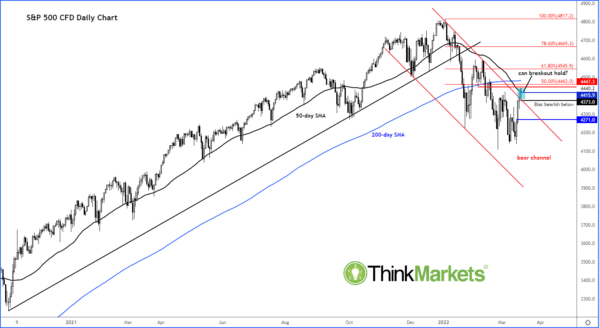Stocks end week on the front-foot as S&P 500 eyes breakout. But will this prove to be a bull trap, given the technical “death crossover” signal, as well as macro concerns such as Ukraine-Russia conflict, soaring inflation and Fed tightening?
If you look at the financial markets this week, it was as if the Ukraine war never happened, or the Fed was not very hawkish. Stock markets roared back higher and were to close solidly in the black. This was the second consecutive weekly positive close for European indices, but the first one for Wall Street and Asia Pacific (APAC) markets. STOXX Europe 600 erased all the losses it had suffered since the invasion of Ukraine began. Risk-sensitive commodity dollars surged higher, while safe-haven Japanese yen and gold slumped. Yen pairs had a wonderful week. Cryptocurrencies traded mostly higher. Crude oil bounced sharply off the lows but was still set to end lower for the second consecutive week.
Ukraine-Russia ceasefire hopes
This week’s gains for most risk assets came despite continued uncertainty over the situation in Ukraine. Earlier in the week, Russia said that reports of major progress in peace talks are wrong and that their delegation is putting colossal energy into peace talks, but Ukraine is simply wasting time. Still, the markets were more eager to rally on any positive headlines than to sell off on negative news. Indeed, sentiment improved towards the latter parts of the week. According to comments from the Russian negotiator on Friday, the two sides were now ‘halfway there’ on the issue of Ukraine’s demilitarization, and that on the issues where their views are most-closely aligned is Ukraine’s neutral status and not joining NATO. Let’s see if Ukraine officials say something similar in the days ahead. If so, the end of the war could be closer, but with Ukraine and Russian being engaged in a war, nothing is guaranteed.
Watch FedSpeak
As well as the ongoing situation in Ukraine, the focus in the week ahead will also be on Fedspeak, with Powell speaking on both Monday and Wednesday. The Fed has signalled a much stronger appetite to combat inflation, indicating a further 6 rate increases in 2022. Judging by comments from some of the Fed officials that have spoken, there is a possibility that we may even see a 50 basis point increase in May. Let’s see if there is much appetite for that, and what plans they might have for running down the central bank’s $8.9 trillion balance sheet.
In terms of macro data, the highlights include durable goods orders and housing market data. From the UK, we have CPI and retail sales, while in Switzerland, the SNB will be making a “decision” on interest rates. Hint: no rate increases are coming. Another set of key data will be the latest PMI numbers, due on Wednesday from Eurozone.
S&P 500 breakout vs. death cross
A lot was made of the S&P’s so-called “death-cross,” but we haven’t seen much downside action. The “death cross” on the S&P describes the fact the 50-day has fallen beneath the 200-day moving average. This usually happens as a result of a correction or sell-off, which makes it a bit of a lagging indicator. Nonetheless, it provides an objective signal, telling traders that the market is no longer in an uptrend. As such, some traders and fund managers would be less inclined or unwilling to look for long trades in such a market. Others might even use this signal to look for short trades. So, it has some important implications. But by the time the moving average crossover happens, the bulk of the price move may have already taken place, as has been the case now. The bears need to see the S&P remain or go back inside its bearish channel again, otherwise the bulls will remain in charge.














